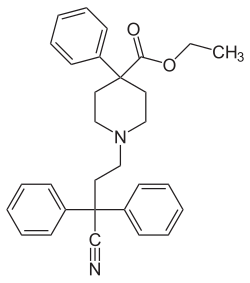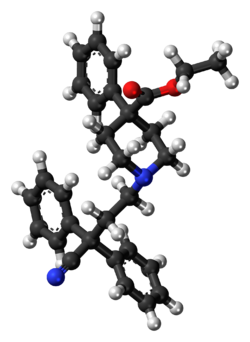The examples and perspective in this United States may not represent a worldwide view of the subject.(October 2025) |
 | |
 | |
| Clinical data | |
|---|---|
| Other names | R-1132, NIH-756 |
| AHFS/Drugs.com | Monograph |
| Routes of administration | Oral |
| Drug class | Opioid Antidiarrheal |
| ATC code | |
| Legal status | |
| Legal status |
|
| Pharmacokinetic data | |
| Protein binding | 74–95% |
| Elimination half-life | 12–14 hours |
| Identifiers | |
| |
| CAS Number | |
| PubChem CID | |
| IUPHAR/BPS | |
| DrugBank | |
| ChemSpider | |
| UNII | |
| KEGG | |
| ChEBI | |
| ChEMBL | |
| CompTox Dashboard (EPA) | |
| ECHA InfoCard | 100.011.837 |
| Chemical and physical data | |
| Formula | C30H32N2O2 |
| Molar mass | 452.598 g·mol−1 |
| 3D model (JSmol) | |
| |
| |
| | |
Diphenoxylate is a centrally active opioid drug of the phenylpiperidine series that is used as a combination drug with atropine for the treatment of diarrhea. Diphenoxylate is an opioid and acts by slowing intestinal contractions; the atropine is present to prevent drug abuse and overdose. It should not be given to children due to the risk that they will stop breathing and should not be used in people with Clostridioides difficile infection.